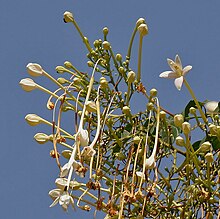Millingtonia
| Millingtonia | |
|---|---|

| |
| Scientific classification | |
| Kingdom: | Plantae |
| Clade: | Tracheophytes |
| Clade: | Angiosperms |
| Clade: | Eudicots |
| Clade: | Asterids |
| Order: | Lamiales |
| Family: | Bignoniaceae |
| Tribe: | Oroxyleae |
| Genus: | Millingtonia L.f. |
| Species: | M. hortensis |
| Binomial name | |
| Millingtonia hortensis L.f. | |
| Synonyms[1] | |
| |
Millingtonia hortensis, the tree jasmine or Indian cork tree, is the sole species in the genus Millingtonia,[2] a tree native to South Asia and South East Asia.
In the name Millingtonia hortensis, Millingtonia is named for Sir Thomas Millington who was an inspiration to Carl Linnaeus the Younger who first described the genus.[3] The specific epithet 'hortensia' derives from 'hortensis' and 'hortus' which in Latin is related to the garden. In its synonym, Bignonia suberosa, 'suberosa' derives from 'suberos' which means 'corky' in Latin.[4]
Millingtonia Avenue in Lucknow is named after Millingtonia hortensis.[5]
Description
The tree grows to a height of between 18 and 25 metres and has a spread of 7 to 11 metres. It reaches maturity between 6 and 8 years of age and lives for up to 40 years. It is a versatile tree which can grow in various soil types and climates with a preference for moist climates.[4] Like Nyctanthes arbor-tristis, it blooms in night and sheds during morning. Flowers give very pleasant smell.
Stem
The tree is evergreen and has an elongated pyramidal stem. The soft, yellowish-white wood is brittle and can break under strong gusts of wind.[4]
Leaf
The leaf is imparipinnate[2] and resembles that of the neem. Leaves are prone to attack by Acherontia styx and Hyblaea puera.[6]
Flower
The white flowers come as large panicles which emit a pleasant fragrance. They are bisexual and zygomorphic. The bell-shaped sepals of the flower have five small lobes. The flower has four stamens with parallel anthers unlike in most other plants of this family where the anthers are divergent. The corolla is a long tube with five lobes.[2]
Fruit and seed
The fruit is a smooth flat capsule and is partitioned into two. It contains broad-winged seeds.[2] The fruits are fed on by birds which aid in seed dispersal. In cultivation, the viability of seeds is low unless they are sown immediately after the fruit ripens, so the plant is generally propagated through cuttings.
Uses
The tree is considered ornamental and the pleasant fragrance of the flowers renders it ideal as a garden tree. The wood is also used as timber and the bark is used as an inferior substitute for cork.[7] The leaves are also used as a cheap substitute for tobacco in cigarettes.[8]
Views of different aspects
- In Hyderabad, India
- In Hyderabad
- In Hyderabad
- In Hyderabad
- In Hyderabad
- In Hyderabad
References
- ^ "The Plant List: A Working List of All Plant Species". Retrieved 2 December 2014.
- ^ a b c d Lindley, John; Moore, Thomas (1866). The Treasury of Botany. Longmans, Green & Co. pp. 1260. Retrieved 1 May 2011.
genus Millingtonia.
- ^ Wad, William (1827). Mems. Maxims, and Memoirs. Callow and Wilson. p. 219. ISBN 978-81-7017-335-9. Retrieved April 30, 2011.
- ^ a b c Arvind, Krishan (2001). Climate Responsive Architecture: A Design Handbook for Energy Efficient Buildings. Tata Mcgraw-Hill. p. 399. ISBN 978-0-07-463218-5. Retrieved April 30, 2011.
- ^ Valsalakumari, P. K. (2008). Flowering Trees. New Delhi: New India Pub. Agency. p. 288. ISBN 978-81-89422-50-9. Retrieved 30 April 2011.
- ^ Ananthakrishnan, T.N. (2004). General and Applied Entomology. Tata Mcgraw-Hill. p. 795. ISBN 978-0-07-043435-6. Retrieved April 30, 2011.
- ^ Sharma, O.P. (1993). Plant Taxonomy. Tata Mcgraw-Hill. p. 353. ISBN 978-0-07-460373-4. Retrieved April 30, 2011.
- ^ Mansfeld's Encyclopedia of Agricultural and Horticultural Crops. Springer. 2001. p. 3645. ISBN 978-3-540-41017-1. Retrieved 30 April 2011.






